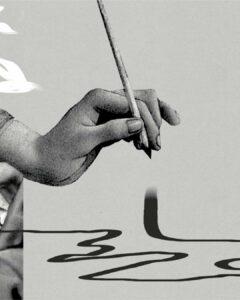
Listen to the article.
The 75th Berlin International Film Festival took place against the backdrop of rising right-wing influence in Germany. Over the past two years, the Berlinale has increasingly mirrored the country’s political agenda, leading to growing disillusionment among independent directors and film professionals. One notable incident last year underscored this shift: the Minister of Culture faced backlash for applauding the Palestinian documentary No Other Land (2024, dir. Yuval Abraham, Basel Adra, Rachel Szor, Hamdan Ballal). Her defense—that the applause was intended for the Israeli co-director—exposed the political sensitivities shaping the state-funded festival’s direction. Adding to the upheaval, it was announced that artistic director Carlo Chatrian and most of the curatorial team would be leaving the festival.
Under her artistic and structural changes, new director Tricia Tuttle eliminated the “Encounters” program––which had curated experimental films exploring new languages in cinema–– and created the “Perspectives” program for debut feature films instead. With this new arrangement, the “Forum” became the festival’s sole platform for experimental and alternative cinema. This program, though part of the Berlinale, is independently curated by Arsenal (Institute for Film and Video Art), consisting of three sections: “Forum,” “Forum Expanded”, and the newly added “Forum Special.”
In recent years, only one film with Armenian themes has been screened at the Berlinale (“Forum Expanded”)––the experimental documentary Black Bach Artsakh (2021) by Ayreen Anastas (Palestine) and Rene Gaber (Iran). The only Armenian production film in the main program was Mikayel Dovlatyan’s Labyrinthe (1996). This year marked a change, with two Armenian films presented: Tamara Stepanyan’s My Armenian Ghosts (Mes fantômes arméniens) in “Forum Special” and Christine Haroutounian’s After Dreaming in “Forum”.
The documentary film My Armenian Ghost is director Tamara Stepanyan’s melancholic tribute to her father, actor Vigen Stepanyan, who symbolizes Armenian cinema in her life. A co-production between France, Armenia and Qatar, this film is not her first international success. Her previous documentaries––Those From the Shore (2017), Village of Women (2019)––have been screened at prestigious film festivals, including Leipzig and Turin. Stepanyan is now completing her first feature fiction film.
After Dreaming is the first feature film by Armenian-American director Christine Haroutounian: a post-war road movie that follows the journey of the main characters Atom and Claudette in what feels like a voyage beyond time and space. The film, a co-production between Armenia, the United States and Mexico, includes renowned Mexican director Carlos Reygadas among its executive producers. Haroutounian’s previous short film, World (2021) premiered at the Rotterdam International Film Festival and won “Best Short Film” at the Golden Apricot Yerevan International Film Festival. The New York–based magazine Filmmaker named her among their “25 New Faces of Independent Cinema”.
This unprecedented event prompts various reflections and analysis. While it represents a significant achievement for Armenian cinema, there is a neo-colonial aspect to consider—namely, that national film success is measured by inclusion in Western festivals like Cannes, Berlin, or Venice. The two share parallels: both were directed by Armenian women living abroad (Tamara, though born in Armenia, lives in France, and Christine is based between Los Angeles and Yerevan, and both are three-country co-productions. Though they differ greatly in theme and style, they both subtly address urgent Armenian issues. Their narratives manage to be both deeply personal and universally resonant.
While fully acknowledging the directors’ achievements and the artistic merit of their films, it is clear that major international festival selections are often guided by specific considerations and political dynamics. Since 2020, festivals have pursued gender parity in their programming, sometimes giving women directors preferential consideration––though this doesn’t affect male directors who already enjoy festival favor and are not part of this competition. .
Major festivals often select films that adhere to established norms of cinematic language and aesthetics—narrative structure, visual composition, and pacing. Directors with international experience, whether from living or studying abroad, tend to grasp these preferences more intuitively. In international co-productions, creative teams from different countries offer external perspectives that help tailor narratives for global audiences. International producers also play a key role, leveraging their festival networks to spotlight select films. Directors with prior exposure on the festival circuit are more likely to attract curators’ attention.
At the same time, these festivals strive for thematic and geographical diversity in their programming. In recent decades, predominantly white and European lineups have faced strong criticism, leading festivals to include more films from other regions—particularly from so-called exotic countries. However, this approach verges on neo-colonial logic. When selecting films from these “exotic” countries, festivals impose a key condition: the films must not take clear political stances against specific regimes. Films from such countries are expected to remain apolitical or avoid overt criticism of specific regimes. Anti-Azerbaijani, anti-Armenian, or anti-Israeli messages are discouraged, while critiques of regimes like Russia or Saudi Arabia, deemed acceptable targets in Western discourse, are welcomed and even celebrated.
Recent developments in Armenian cinema reveal a clear trend: international audiences and film festivals are increasingly drawn to Armenian stories and regional narratives. This growing interest has enhanced Armenia’s visibility on the global film market and invigorated its domestic film scene. Local festivals and industry platforms now serve as vital bridges, connecting Armenian filmmakers with international opportunities through workshops, residencies and networking initiatives.
The selection of international film festivals remains a complex matrix of political calculations and double standards. For example, a Georgian director’s statement “I hope Russia will burn to ashes” receives applause, while “From the river to the sea, Palestine will be free” is flagged as warranting caution on the Berlinale’s official website. Similarly, Armenian stories will also be expected to maintain a “cautious” line. Yet despite these constraints, Christine Haroutounian and Tamara Stepanyan have succeeded in crafting beautiful and universally resonant narratives that preserve their Armenian identity and contemporary relevance.
Et Cetera
Unpacking Victory: A Curatorial Response to War
The exhibition “Victory Over the Victory” critically reexamines war and its legacies, bringing together global artists to challenge war narratives and explore memory, trauma and resistance. Curators Sona Stepanyan and Natasha Dahnberg create a space for dialogue across geographies and generations.
Read moreWomen, Peace, Art: Breaking or Reinforcing Stereotypes?
The "Women, Peace, Art" exhibition in Armenia showcased eight female artists addressing peace amid war's haunting memories. While ambitious, the exhibition struggled with essentialist portrayals of women, often reinforcing stereotypes instead of challenging them.
Read moreArchitecting a New Language of Sustainable Practices in Armenia
Amid Yerevan’s chaotic development, grassroots initiatives led by local and diasporan architects are reimagining Armenia’s architectural landscape. By fostering dialogue and hands-on learning, they aim to rethink building practices and promote responsible, sustainable approaches to architecture.
Read more



